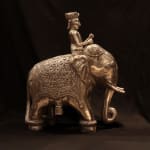Silver Statue of an Elephant and Detachable Rider with Incised Mughal Motifs, 18th to 19th Century CE
Silver
53.3 x 47 cm
21 x 18 1/2 in
21 x 18 1/2 in
LI.3519
Further images
-
(View a larger image of thumbnail 1
)

-
(View a larger image of thumbnail 2
)

-
(View a larger image of thumbnail 3
)

-
(View a larger image of thumbnail 4
)

-
(View a larger image of thumbnail 5
)

-
(View a larger image of thumbnail 6
)

-
(View a larger image of thumbnail 7
)

-
(View a larger image of thumbnail 8
)

-
(View a larger image of thumbnail 9
)

-
(View a larger image of thumbnail 10
)

-
(View a larger image of thumbnail 11
)

-
(View a larger image of thumbnail 12
)

This delicately ornate silver sculpture of an elephant and detachable rider is testimony to the artistic refinement the Mughal dynasty experienced during the 18th Century. Often associated with Hindu and...
This delicately ornate silver sculpture of an elephant and detachable rider is testimony to the artistic refinement the Mughal dynasty experienced during the 18th Century. Often associated with Hindu and Buddhist iconography, the creature retained its saint-like status even during Islamic rule. The sculpture is incised with floral motifs and Persian girih geometrical patterns.
The Elephant appears as one of the most venerated animals within the Indian subcontinent. This majestic creature has featured prominently in South Asian culture for several millennia, from the prehistoric Bhimbetka cave paintings to its current-day status as a divine deity. The magnitude of influence the elephant has in the region has been most recognisably characterised by its importance in Indian religion. The mother of Buddha was said to have dreamt of a white elephant before she gave birth to her son. In Hindu mythology, the elephant is materialised in the form of Ganesha, the elephant-headed god of prosperity and well-being, remaining one of the most revered deities in the Hindu pantheon.
The Mughal Empire was one of the most powerful and influential empires within the South Asian subcontinent, stretching from the edge of the Indus river basin to Bangladesh in the East. The Islamic empire reigned from the 16th to the 19th century, led by notable rulers such as Akbar, Aurangzeb, and Shah Jahan. The Mughals contributed greatly to the regional architectural styles of South Asia, establishing national monuments in present-day India, Pakistan, Bangladesh, and Afghanistan.
The Elephant appears as one of the most venerated animals within the Indian subcontinent. This majestic creature has featured prominently in South Asian culture for several millennia, from the prehistoric Bhimbetka cave paintings to its current-day status as a divine deity. The magnitude of influence the elephant has in the region has been most recognisably characterised by its importance in Indian religion. The mother of Buddha was said to have dreamt of a white elephant before she gave birth to her son. In Hindu mythology, the elephant is materialised in the form of Ganesha, the elephant-headed god of prosperity and well-being, remaining one of the most revered deities in the Hindu pantheon.
The Mughal Empire was one of the most powerful and influential empires within the South Asian subcontinent, stretching from the edge of the Indus river basin to Bangladesh in the East. The Islamic empire reigned from the 16th to the 19th century, led by notable rulers such as Akbar, Aurangzeb, and Shah Jahan. The Mughals contributed greatly to the regional architectural styles of South Asia, establishing national monuments in present-day India, Pakistan, Bangladesh, and Afghanistan.











